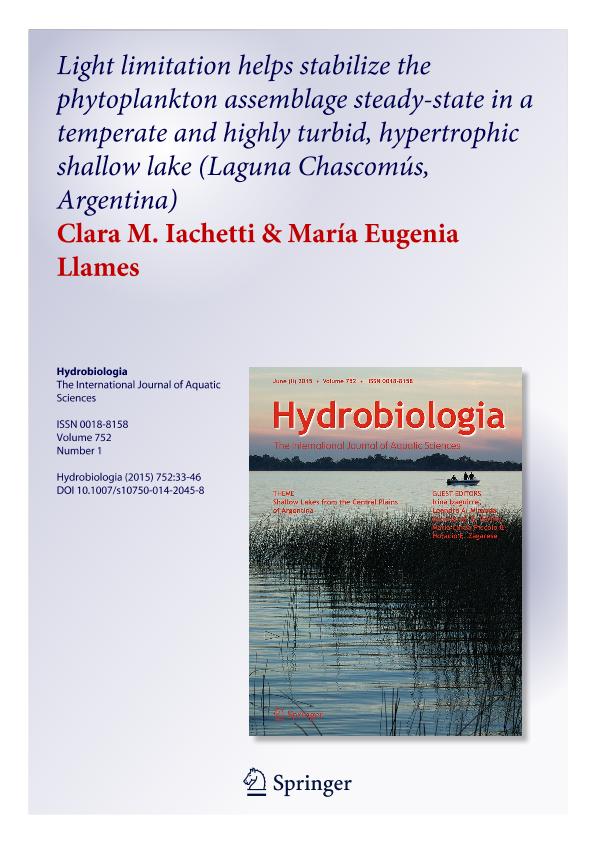Mostrar el registro sencillo del ítem
dc.contributor.author
Iachetti, Clara Margarita

dc.contributor.author
Llames, Maria Eugenia del Rosario

dc.date.available
2018-01-10T18:01:14Z
dc.date.issued
2014-09
dc.identifier.citation
Llames, Maria Eugenia del Rosario; Iachetti, Clara Margarita; Light limitation helps stabilize the phytoplankton assemblage steady-state in a temperate and highly turbid, hypertrophic shallow lake (Laguna Chascomús, Argentina); Springer; Hydrobiologia; 752; 1; 9-2014; 33-46
dc.identifier.issn
0018-8158
dc.identifier.uri
http://hdl.handle.net/11336/32848
dc.description.abstract
We performed a 30-month field study in a highly turbid, hypertrophic shallow lake from the Pampa Plain (Argentina) in order to investigate the occurrence of steady-state phases of phytoplankton, with an emphasis on the effect of subtle, but measurable, increase in light availability. The results revealed that a steady-state condition prevailed during the first 14 months, during which Aphanocapsa cf. delicatissima represented, on average, 91% of the total phytoplankton biomass. The statistical analyses provide support for the hypothesis that low light availability in the water column regulates the structure of the algal assemblage in this lake. Our results agree with predictions of the light-limited growth theory (i.e. the observed increase in light supply promoted an increase in algal density) and are also consistent with the notion that environmental constraints influence the dominant morphological traits in phytoplankton assemblages, particularly, that small organisms and/or attenuated forms are favoured under very poor light conditions. Nevertheless, further work is needed to get a full understanding of the processes controlling phytoplankton dynamics in this lake, including careful studies of the ecophysiology of the colonies comprising pico-sized cells of Aphanocapsa cf. delicatissima that dominated the assemblage during all the studied period.
dc.format
application/pdf
dc.language.iso
eng
dc.publisher
Springer

dc.rights
info:eu-repo/semantics/openAccess
dc.rights.uri
https://creativecommons.org/licenses/by-nc-sa/2.5/ar/
dc.subject
Phytoplankton
dc.subject
Steady-State
dc.subject
Shallow Lake
dc.subject
Cyanobacteria
dc.subject
Turbid Systems
dc.subject.classification
Otras Ciencias Biológicas

dc.subject.classification
Ciencias Biológicas

dc.subject.classification
CIENCIAS NATURALES Y EXACTAS

dc.title
Light limitation helps stabilize the phytoplankton assemblage steady-state in a temperate and highly turbid, hypertrophic shallow lake (Laguna Chascomús, Argentina)
dc.type
info:eu-repo/semantics/article
dc.type
info:ar-repo/semantics/artículo
dc.type
info:eu-repo/semantics/publishedVersion
dc.date.updated
2018-01-10T16:52:02Z
dc.journal.volume
752
dc.journal.number
1
dc.journal.pagination
33-46
dc.journal.pais
Alemania

dc.journal.ciudad
Berlin
dc.description.fil
Fil: Iachetti, Clara Margarita. Consejo Nacional de Investigaciones Científicas y Técnicas. Centro Científico Tecnológico Conicet - La Plata. Instituto de Investigaciones Biotecnológicas. Instituto de Investigaciones Biotecnológicas "Dr. Raúl Alfonsín" (sede Chascomús). Universidad Nacional de San Martín. Instituto de Investigaciones Biotecnológicas. Instituto de Investigaciones Biotecnológicas "Dr. Raúl Alfonsín" (sede Chascomús); Argentina
dc.description.fil
Fil: Llames, Maria Eugenia del Rosario. Consejo Nacional de Investigaciones Científicas y Técnicas. Centro Científico Tecnológico Conicet - La Plata. Instituto de Investigaciones Biotecnológicas. Instituto de Investigaciones Biotecnológicas "Dr. Raúl Alfonsín" (sede Chascomús). Universidad Nacional de San Martín. Instituto de Investigaciones Biotecnológicas. Instituto de Investigaciones Biotecnológicas "Dr. Raúl Alfonsín" (sede Chascomús); Argentina
dc.journal.title
Hydrobiologia

dc.relation.alternativeid
info:eu-repo/semantics/altIdentifier/doi/http://dx.doi.org/10.1007/s10750-014-2045-8
dc.relation.alternativeid
info:eu-repo/semantics/altIdentifier/url/https://link.springer.com/article/10.1007%2Fs10750-014-2045-8
Archivos asociados
